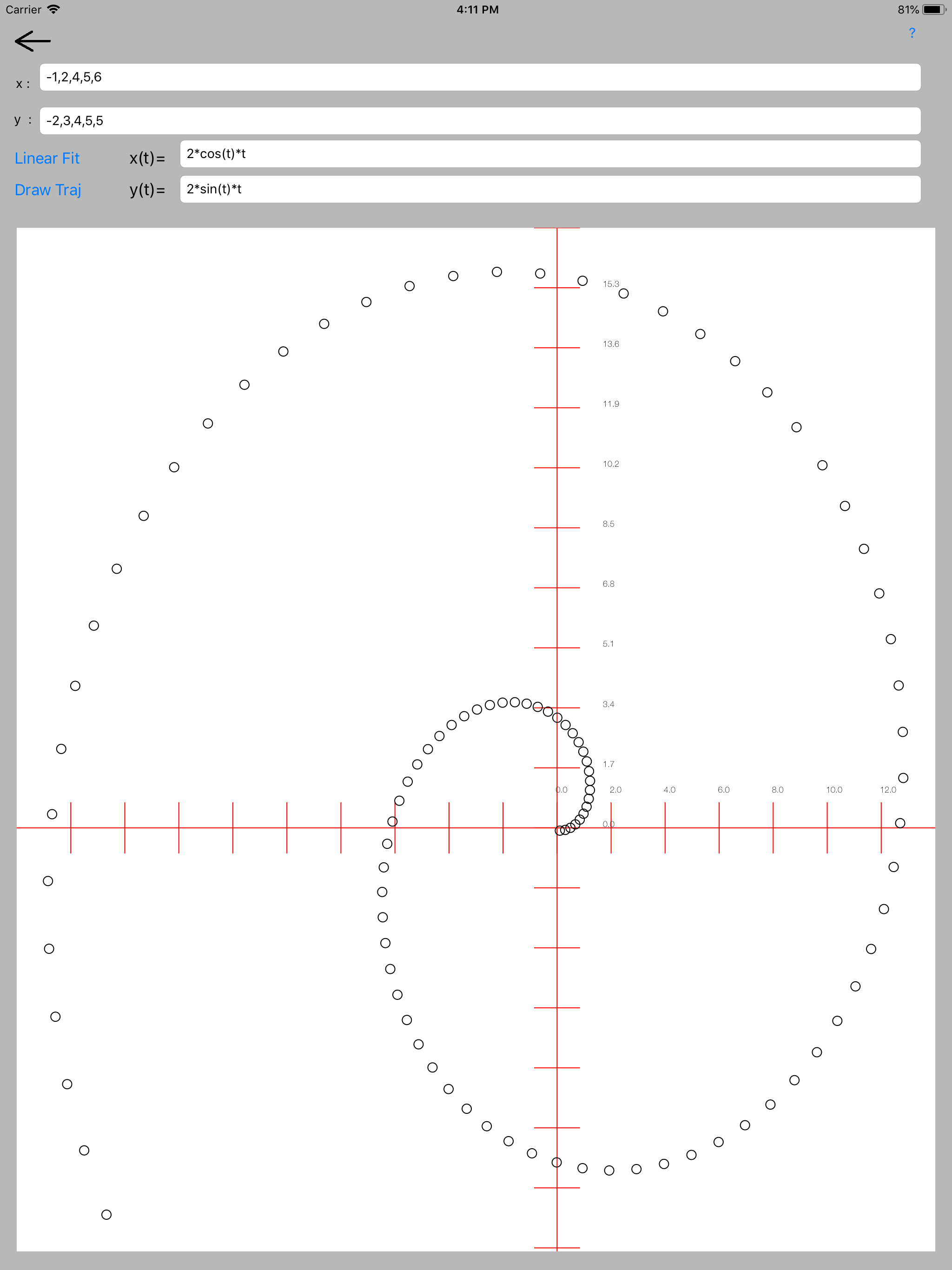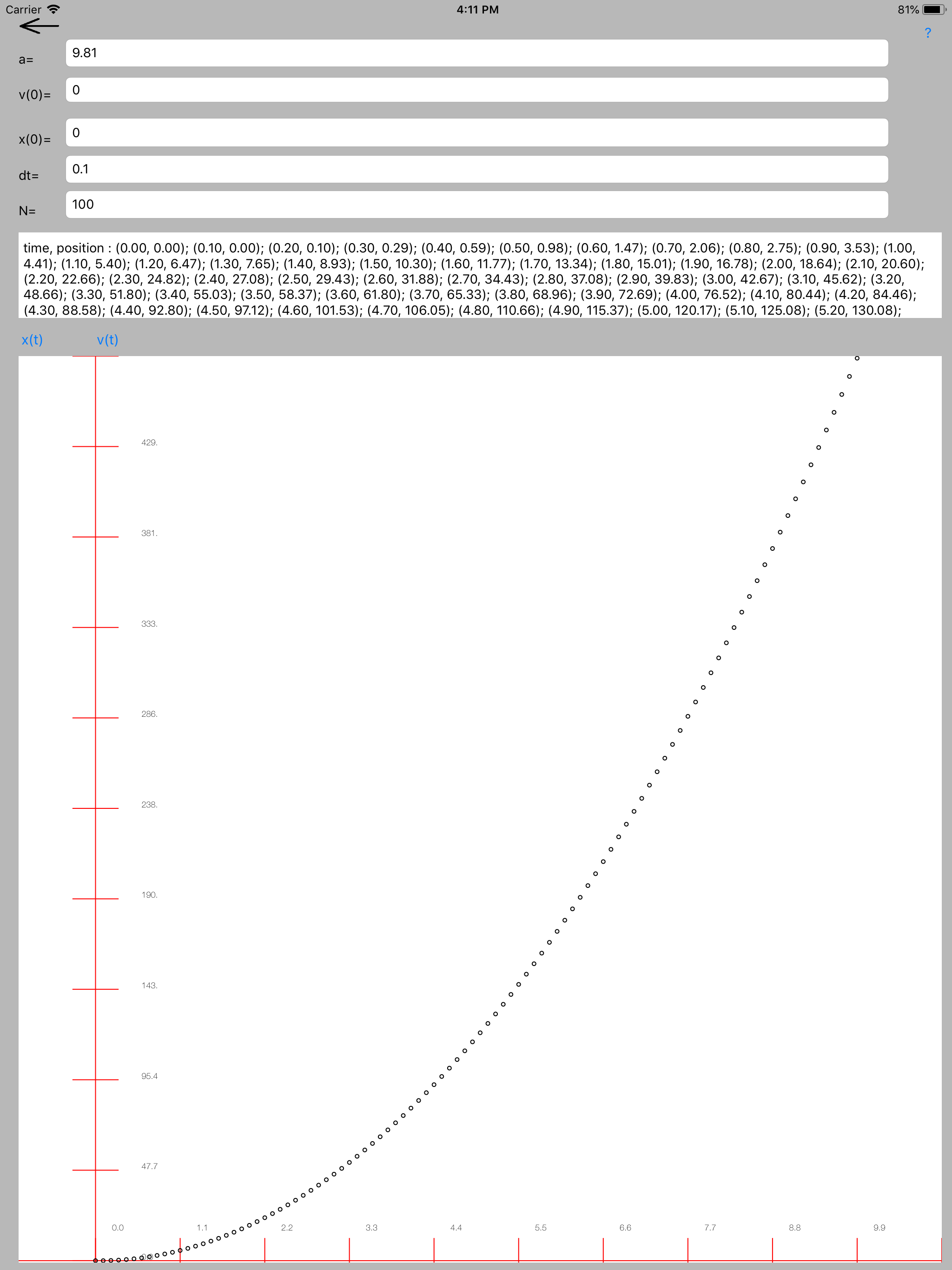
The graphical tools are here to do two different tasks. The first one is to do simple lienar interpolation.
This is you give a point list and the calculator will perform linear interpolation using standard methods. To perform
linear interpollation you just need to give the points each point will be represented by two coordinates (x, y), fill in the
coresponding fields, the x-coordinates and the y-coordinates. Be carefull to seperate values using a comma (,). Then press
linear fit and you will obtain the slope and y-intercept of the line approximating the data.
The other tool is the representation of a trajectory. Assuming that the mouvement starts at t=0 the calculator will then compute
the other points, you will need to give the time step between two points, the default value is t=0.1 the other parameter you have to specify
is the number of points to calculate again the default value is fixed to be N=100. The two fields x(t) and y(t) represent the
parametric equations of the trajectory, fill in those two press the draw traj. button and you will be prompted to chose the time step and
number of points leaving these data blank will cause the calculator to use the default values. The spiral drawn in the picture has
parametric equations given by x(t)=2*cos(t)*t and y(t)=2*sin(t)*t. See section below for the list of suported functions and mathematical notations.

The objective of the motion solver is to find, numerically a solution to the equation of motion. You start by giving the calculator the expression
of acceleration. Using Newton's law we have simply, a=F/m the calculator will obtain velocity, v(t) and position x(t). The calculator
uses the Cauchy fixed step algorithm to perform this task. It is : the new point is given by a function of the old one, new velocity = a*dt +
old velocity. So you need to fix the time step that will be linked with precision and the number of points calculated. You have the choice to display
position x(t) or velocity v(t). The middle text field gives you the numerical values obtained.
A nice motion you can use as a try is the particle falling with gravity and subject to a friction proportional to vlelocity or square velocitiy. This is
F = mg-cv^2 leading to a = g-0.2*v^2 (try this exemple !) and ask for the velocity plot!
The last but not least features of the calculator is the derivative calculator, as it names suggests it computes derivtives of functions in symbolic form. Just type in a function the
f(x)= field and you will obtain by pressing the calculate button the first and second derivative of the function. If the function is "simple" the calculator will also give
you a primitive (anti-derivative) of the function. The list of functions suported for both numerical and symbolic calculations is :
sin(x), cos(x), tan(x), sinh(x), cosh(x), tanh(x), exp(x), ln(x), acsin(x), acos(x), atan(x) and sqrt(x) for the square root.
This list is not definitive it will be extented with future versions of the calculator. If the derivative calculator gives you zero for a derivative you should be aware that
in very rare cases it is because the calculator was unable to compute the derivative: It happens if you give him an unknown function. It was mentioned higher that
for simple functions the calculator gives you the primitive. Simple functions are those where integration can be performend without variable change and without
recursive integration by parts. So for nearly all every functions you should obtain a primitive.
To finish this gide just a few considerations about the mathematical notations used by the calculator. Notations are all quite standard, the arithmetic operators are :
+ - * / the multiplication operator has always to be explicitly written. The power operator is ^ and the square root function is sqrt(x). For the moment only positive integers are suported as exponents so you should use division instead,
x^(-2) is 1/(x^2). Try a few functions to see, f(x) = x*sin(x)
As those lines are written there is no known issue. So we can focus on future evolution of the calculator. More functions will be added and the integrator will become better. For any questions or request just send me an Email